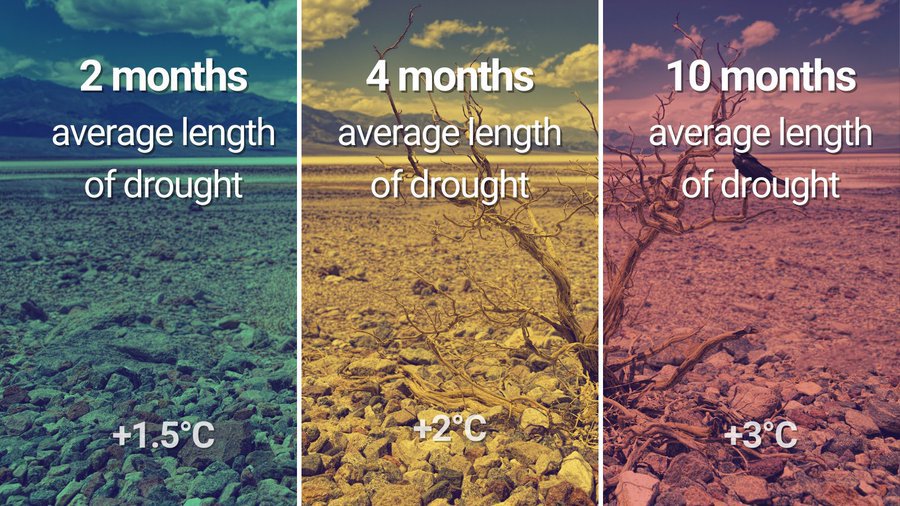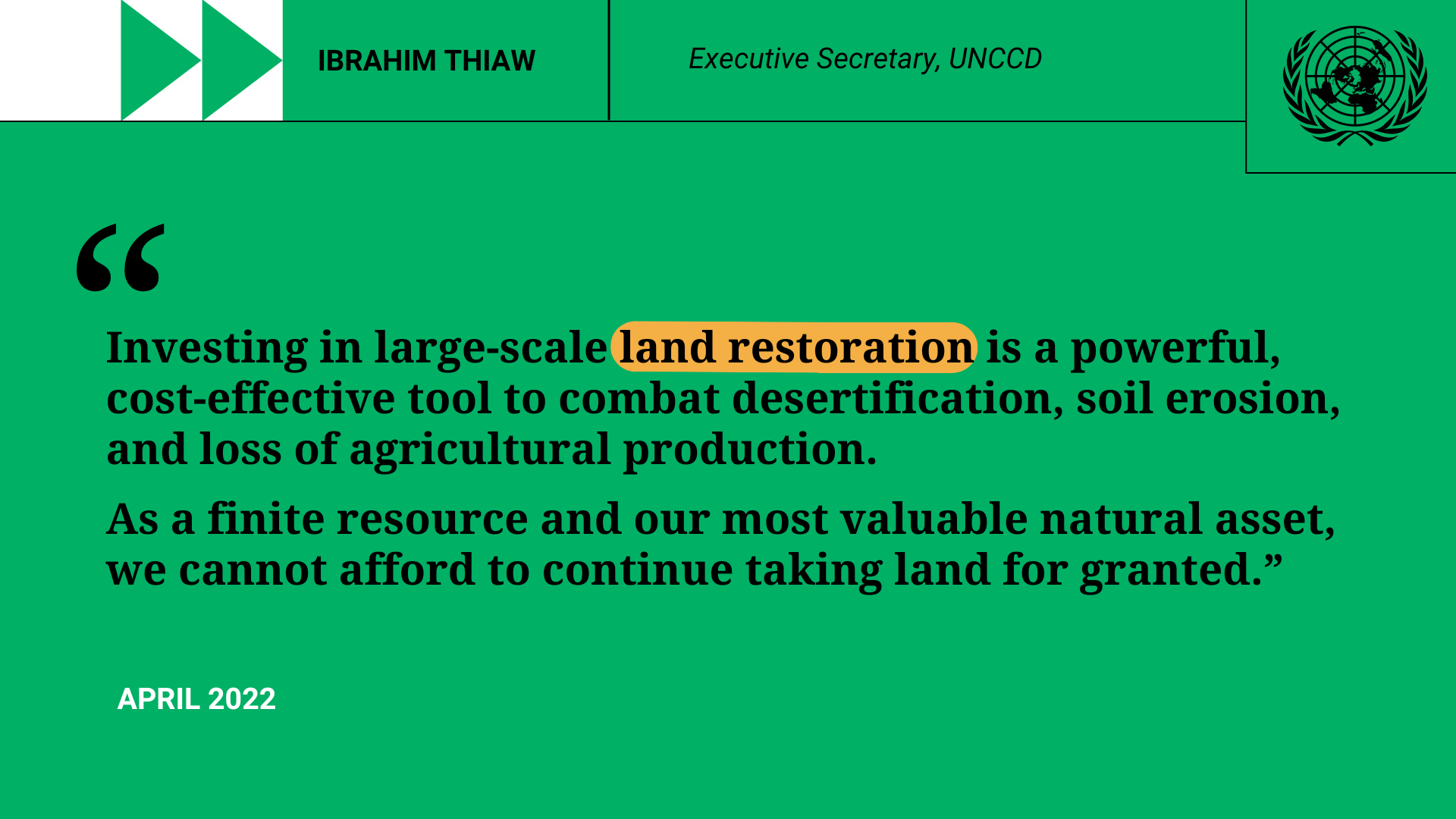
The world’s land — including its mountains, hills, plateaus and plains — provides vital services, such as oxygen, food and water, that are essential for life. Land is also home to much of the world’s biodiversity.
Land “plays a key role in the climate system” as an essential carbon sink because its surfaces, such as forests, regulate the planet’s temperature and help to store carbon. In the last decade alone, land-based ecosystems absorbed around 30 per cent of the carbon emissions generated by human activities, such as the burning of fossil fuels.
But our land is under increasing pressure from deforestation, urbanization, industrial development, agricultural expansion and unsustainable farming practices that are undermining its ability to sustain food production, maintain freshwater and forest resources, as well as regulate the climate and air quality.
And a changing climate, in turn, exacerbates land degradation through drought, desertification and other extreme weather events that are increasing in frequency and intensity as the planet gets warmer.
State of our land
Today, up to 40 per cent of the world’s land surface has been degraded including 30 per cent of its cropland and 10 per cent of its pastureland.
In the last fifty years, the area of drylands in drought has increased on average by more than 1 per cent per year — affecting mostly countries in Africa and Asia. If we continue to misuse our land, we could degrade a surface area as vast as the size of South America by 2050.
When land is degraded, it impacts food security, water availability and ecosystem health, directly affecting half of humanity, and causing a loss of about US$40 trillion worth of ecosystem services each year — nearly half of the global GDP of $93 trillion in 2021.
Land degradation is also considered “the single greatest cause of terrestrial biodiversity loss,” resulting in the destruction of the habitats of many animals and plants. Severe degradation such as drought and desertification can also devastate communities, leading to social and economic instability. Up to 250 million people could be displaced by 2050 as a result of climate change-induced desertification.
Land and climate change
How does land degradation impact climate change? It decreases the soil’s ability to store carbon. Moreover, when forests are cleared or burnt, they release the carbon they have stored. A 2018 UN report found that deforestation alone contributed about 10 per cent of all human-induced greenhouse gas emissions.
Between 2000 and 2009, annual greenhouse gas emissions from degraded land accounted for up to 4.4 billion tonnes of carbon dioxide (CO2) emissions — in comparison, the global energy-related CO2 emissions were considered to reach their highest ever level in 2021 at 36.3 billion tonnes.
And as the planet warms, extreme weather events, including longer and more intense droughts, heavier rainfall leading to floods and landslides, and more frequent and intense tropical storms, worsen land degradation.
 Projected length of drought with every 0.5°C temperature increase. SOURCE: UNFCCC
Projected length of drought with every 0.5°C temperature increase. SOURCE: UNFCCC
The IPCC warns that droughts will lead to soil erosion as well as reduced crop yields, while floods and landslides can destroy agricultural lands and infrastructure. Tropical storms can uproot trees and damage crops.
Heatwaves have caused significant agricultural losses, including in the world’s major breadbasket regions in the last few decades, with major consequences for global food security.
Additionally, climate change causes sea levels to rise, leading to coastal flooding and erosion. Such impacts have serious economic, social and environmental impact on countries and communities around the world, and scientists caution that these impacts will only become more severe in the future.
Without efforts to restore and protect land, nearly 70 gigatonnes more carbon would be emitted by 2050 due to land use change and soil degradation, representing approximately 17 per cent of current annual greenhouse gas emissions.
Changing the way we use land

The good news is that there are ways to improve land degradation. One way is through restoration, which includes agroforestry, grazing management, and assisted natural regeneration, and the protection of areas important for biodiversity and the provision of natural resources such as water.
Sustainable land management practices, such as using more efficient irrigation systems and crop rotations, can protect ecosystems and the communities that depend on them, as well as help to regulate local climate patterns, improve water quality, and safeguard biodiversity.
Socio-economic gains of land restoration
The economic gains from land restoration, including its impact on emission cuts and the prevention of biodiversity loss, could be significant, amounting to up to $140 trillion per year — which is 50 per cent more than the global GDP in 2021.
If we used just $1.6 trillion of the annual amount of $700 billion spent on subsidies for the fossil fuel and agricultural industries over the next ten years, countries would be able to restore some 1 billion degraded hectares of land — an area the size of the United States or China, including 250 million hectares of farmland.
Land also has a great potential to provide renewable energy — through bioenergy which is produced from a variety of organic materials such as plant and animal matter. Today, bioenergy is one of the largest sources of renewable energy globally, accounting for 55 per cent of renewable energy and over 6 per cent of global energy supply.
It is also an important source of employment, particularly in rural areas. The biofuels sector provides more than 2 million jobs globally and is expected to grow significantly in the coming years. However, high dependence on biomass, even with the development of improved equipment, can contribute to deforestation, degradation of soil quality and reduced biodiversity.
Visit the UN Environment Programme and the UN Convention to Combat Desertification (UNCCD) websites for more information about the impact of land degradation and the importance of restoration.
Check out the video below created by UNCCD’s Land for Life initiative.
Learn more about…

Elizabeth Wathuti: We can change so much in the world
Elizabeth Wathuti, a Green Climate Fund Youth Champion, calls for solidarity and compassion in our efforts to address the world’s growing climate and ecological crises.

Hindou Ibrahim: Living in harmony with nature
“Indigenous peoples are a solution, we are not only a victim of the climate change,” says SDG Advocate and Indigenous rights activists Hindou Ibrahim.

Elliott Harris: Measure the value of nature – before it’s too late
UN Chief Economist Elliott Harris introduces a ground-breaking shift in valuing nature as a way of making more informed decisions about economies, climate action and the protection of biodiversity.

The Ocean – the world’s greatest ally against climate change
The ocean is central to reducing global greenhouse gas emissions. Here are a few reasons we need to safeguard the ocean as our best ally for climate solutions.

Food and climate change: Healthy diets for a healthier planet
Food needs to be grown and processed, transported, distributed, prepared, consumed, and sometimes disposed of. Each of these steps creates greenhouse gases that trap the sun’s heat and contribute to climate change.

Renewable energy – powering a safer future
Derived from natural resources that are abundant and continuously replenished, renewable energy is key to a safer, cleaner, and sustainable world. Explore common sources of renewable energy here.

Biodiversity
Find out how protecting the world’s biodiversity is essential for limiting carbon emissions and adapting to climate impacts.
